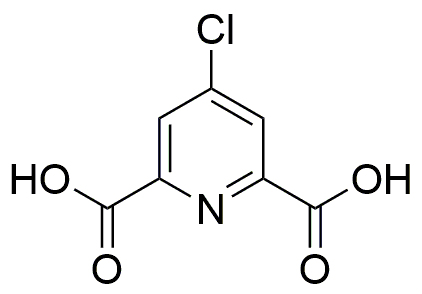4-Chloro-2,6-pyridinedicarboxylic acid is widely utilized in research focused on:
- Agricultural Chemicals: This compound serves as a key intermediate in the synthesis of herbicides, providing effective weed control while minimizing environmental impact.
- Pharmaceutical Development: It is used in the production of various pharmaceuticals, particularly in creating compounds that target specific biological pathways, enhancing therapeutic efficacy.
- Analytical Chemistry: The compound acts as a reagent in analytical methods, aiding in the detection and quantification of other substances, which is crucial for quality control in manufacturing.
- Material Science: It is incorporated into polymers and coatings, improving their chemical resistance and durability, making them suitable for industrial applications.
- Research and Development: This chemical is a valuable tool in academic and industrial labs for studying pyridine derivatives, facilitating advancements in organic chemistry.
General Information
Properties
Safety and Regulations
Applications
4-Chloro-2,6-pyridinedicarboxylic acid is widely utilized in research focused on:
- Agricultural Chemicals: This compound serves as a key intermediate in the synthesis of herbicides, providing effective weed control while minimizing environmental impact.
- Pharmaceutical Development: It is used in the production of various pharmaceuticals, particularly in creating compounds that target specific biological pathways, enhancing therapeutic efficacy.
- Analytical Chemistry: The compound acts as a reagent in analytical methods, aiding in the detection and quantification of other substances, which is crucial for quality control in manufacturing.
- Material Science: It is incorporated into polymers and coatings, improving their chemical resistance and durability, making them suitable for industrial applications.
- Research and Development: This chemical is a valuable tool in academic and industrial labs for studying pyridine derivatives, facilitating advancements in organic chemistry.
Documents
Safety Data Sheets (SDS)
The SDS provides comprehensive safety information on handling, storage, and disposal of the product.
Product Specification (PS)
The PS provides a comprehensive breakdown of the product’s properties, including chemical composition, physical state, purity, and storage requirements. It also details acceptable quality ranges and the product's intended applications.
Certificates of Analysis (COA)
Search for Certificates of Analysis (COA) by entering the products Lot Number. Lot and Batch Numbers can be found on a product’s label following the words ‘Lot’ or ‘Batch’.
Numéro de catalogue
Numéro de lot/série
Certificates Of Origin (COO)
This COO confirms the country where the product was manufactured, and also details the materials and components used in it and whether it is derived from natural, synthetic, or other specific sources. This certificate may be required for customs, trade, and regulatory compliance.
Numéro de catalogue
Numéro de lot/série
Safety Data Sheets (SDS)
The SDS provides comprehensive safety information on handling, storage, and disposal of the product.
DownloadProduct Specification (PS)
The PS provides a comprehensive breakdown of the product’s properties, including chemical composition, physical state, purity, and storage requirements. It also details acceptable quality ranges and the product's intended applications.
DownloadCertificates of Analysis (COA)
Search for Certificates of Analysis (COA) by entering the products Lot Number. Lot and Batch Numbers can be found on a product’s label following the words ‘Lot’ or ‘Batch’.
Numéro de catalogue
Numéro de lot/série
Certificates Of Origin (COO)
This COO confirms the country where the product was manufactured, and also details the materials and components used in it and whether it is derived from natural, synthetic, or other specific sources. This certificate may be required for customs, trade, and regulatory compliance.


